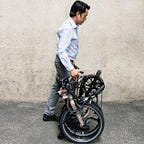Bikes + Gears: Compact Utility Bike (CUB) (Review)
Back in February, we had the privilege of experiencing for the first time to ride a cargo bike. The typical cargo bike or bakfiets (in Dutch) is a bicycle (or sometimes a tricycle) with a large wooden box attached to the front, originall designed for hauling goods from point A to B. (Bruntlett and Bruntlett, 2018).
Cargo bikes are not common in our country. At least not the typical freight bicycles used in other places consisting of an open or enclosed box, a flat platform, or a wire basket, usually mounted over one or both wheels, low behind the front wheel, or between parallel wheels at either the front or rear of the vehicle.
So it is a welcome news that a Filipino would take on the challenge of designing and building a cargo bike for Filipinos.
The Compact Utility Bike (CUB)
This cargo bike is designed and built in a workshop in Batangas by a small team led by Alex Silva. While raising three children together with his wife and living in Kathmandu, Nepal, in Philippines and in Tokyo, cycling has always been part of their lifestyle. Alex considers himself an activist who has been involved in issues of sustainable transportation particularly the promotion of bicycling.
It was while living in the Philippines, around year 2014 that he started building or customizing bicycles to meet their family’s needs. He needed to send their two grade schoolers to school so he built a long tail bicycle. The second was when they started a small bakery and needed a bicycle for delivery and selling. The third was a cargo trike modeled from a Christiania to be used for ferrying materials for our workshop and bakery.
In 2017, Alex’s family moved back to Tokyo for the schooling of children. This time he was exposed already to the design of “front loader bakfiet”. He was very intrigued by the design and intuitively knew that it is a better bicycle than what they have used and what is available in Tokyo. He thought it will be perfect in serving their need of carrying their youngest around.
This situation has led him to a realization that while bakfiet or the long john bicycle has existed in Europe since the 1940s, until this time Japan has not embraced the design and concept of this bicycle. He also realized that to bring and use what is commonly available in Europe will be difficult in Tokyo because of the restriction of space — the infrastructure, particulary parking does not support this type of bicycle.
Also, because of our physique (“Asian size”), the bakfiet is a bit big for Filipinos. He had only one option but to design and build it himself.
And the CUB was born. After a year of using it in their daily life, Alex is now on his third prototype and hopefully the production model. And this is the version that he graciously allowed us to use.
The method of building the CUB was to use junk/used bicycles from Japan. In Japan, many factors contribute to having a big amount of “junk” bicycle. Bicycle repairs are not encouraged. Relatively wealthy population feel bicycles are disposable items like shoes.
The Philippines is one of the destination of these junk bicycles. Ironically, while these junk bicycles leave Japan as garbage, entrepreneurs in the Philippines try to make business by reselling it.
And this gave Alex a eureka moment and decide to use “surplus” bicycles parts from Japan to build the CUB. Learning from and improving on the previous version of the CUB, the version we tested is certainly a good bike to ride on.
The low clearance makes it really comfortable and easy to mount and dismount; and do the balancing act. But soon after you pedal, the CUB’s design naturally kicks in and you’ll get the same riding experience with any type of bike that has a front load. In my case, I am so used to having a full bag of office stuff in my front rack on my daily bike commute and this helped me ride the CUB with ease and familiarity.
The Porteur handlebar in the CUB is the perfect choice as these are designed to accommodate front-mounted racks or baskets in order to haul cargo and are usually found on dedicated cargo bikes.
Alex and his team has installed a 7-speed shifter in this version of the CUB which gives it a nice range to ride with, just perfect for city or urban riding.
The CUB has disc brakes which I think are what’s needed for you to have a good braking power especially with the weight or load you would carry. But it takes some time to be comfortable if you are used to the more common V-brakes in many bicycles.
To help with the balancing, the team has put in a steering damper or steering stabiliser which is a device designed to inhibit an undesirable, uncontrolled movement or oscillation of a vehicle steering mechanism. In other words, a wobbly ride.
I really liked the wooden box they have built and installed in the CUB. It is modular in a sense that you can take off the seat to have more space for goods. While it can only fit one child, it gets the job done and is designed that way. But certainly, the space is large enough to haul your weeklong even monthlong grocery supplies or any cargo for that matter.
That’s our daughter forcing her way to sit on the CUB ahead of her Kuya.
Huge thanks to Alex for not only letting us use the CUB but also generously sharing his life and the bike’s story. 🙂
Our children really enjoyed the CUB and we are looking forward to having one of our own in the near future.
